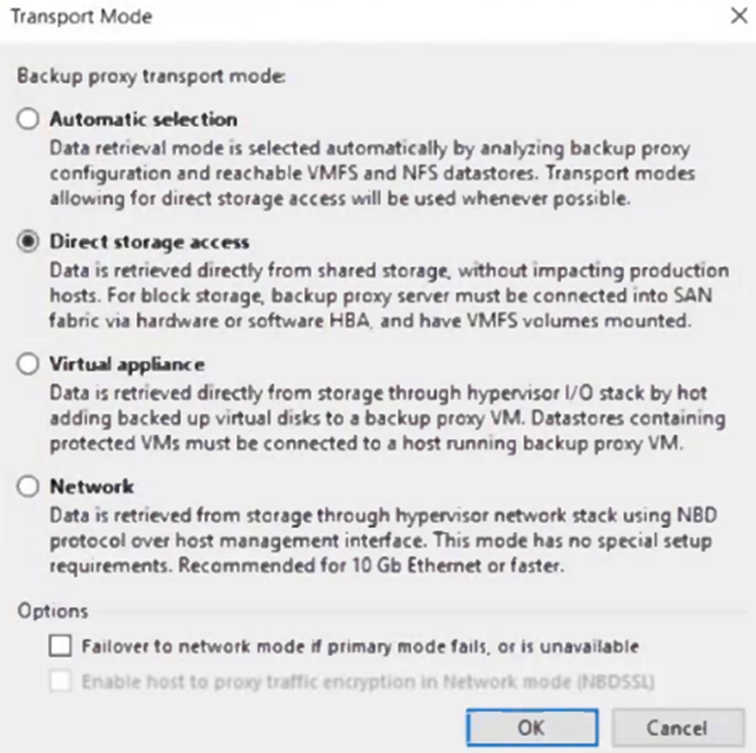Master VEEAM VMCE_v12 Exam with Reliable Practice Questions
A company needs to ensure that, during a disaster, a group of VMs starts in a certain order with time delays between starting each VM. How can this be accomplished?
Correct : B
To ensure that a group of VMs starts in a specific order with time delays during a disaster scenario, the solution is B: Create a failover plan. A failover plan in Veeam Backup & Replication is a feature designed to manage the startup sequence of VMs within a DR site. The failover plan can be customized to specify the order in which VMs should start and to include necessary delays between the startups of each VM. This is especially useful for multi-tier applications where the order of startup is essential for the application stack to become fully operational. By using a failover plan, companies can control the recovery process, ensuring that VMs are brought online in an orderly and coordinated fashion that respects their interdependencies.
Start a Discussions
A Veeam proxy server is configured as follows. No modifications are allowed to the transport mode.
When performing a restore of a VMware virtual disk using this proxy server, the restore fails. What is a possible cause?

Correct : C
Given the provided transport modes and the fact that no modifications are allowed to these settings, a possible cause for the restore of a VMware virtual disk to fail using this proxy server is C: The virtual disk is thin-provisioned. In the transport modes shown, the Direct storage access and Virtual appliance options would require the VM disk files to be accessible in a certain way that might not be compatible with thin-provisioned disks depending on the storage configuration and the current state of the VM. If the storage integration specifics or the snapshot handling do not support the thin-provisioned format, the restore operation could fail. It's important to ensure that the transport mode selected is compatible with the type of virtual disk being restored to prevent such issues.
Start a Discussions
The configuration database is corrupted, and the backup administrator wants to recover the dat
a. Which configuration restore mode should be used?
Correct : B
In the event that the Veeam Backup & Replication configuration database is corrupted, the appropriate action to take is to perform a configuration restore. Veeam Backup & Replication allows you to back up and restore its configuration database. The Restore option should be used to recover the data from a configuration backup. This process will restore the configuration database from the backup file, which includes information about backup jobs, repository settings, and more. Instant Recovery, Failover, and Migrate are not appropriate options for recovering a corrupted configuration database. Instant Recovery is used to quickly restore a VM to a running state, Failover is used for High Availability in case a VM fails, and Migrate is used to move VMs from one host or storage to another.
Start a Discussions
Hourly backup jobs are configured to local repositories. Daily backups must be sent from Site B to the repository on Site
Correct : A, A
For the given scenario where daily backups need to be sent from Site B to a repository at Site A and the connection between the two sites is limited, thus impacting the ability to complete direct backups within the backup window, a Backup Copy Job would be appropriate. A Backup Copy Job is a feature in Veeam Backup & Replication that allows you to create several instances of the same backup files across different locations (repositories).
In the image provided, the components involved in the Backup Copy Job from Site B to Site A would be:
6 (Repository at Site B): This is the source repository where the hourly backup jobs are stored.
4 and 3 (WAN Accelerators at both sites): These components optimize data transfer over the WAN.
2 (Repository at Site A): This is the target repository where the backup copies will be stored.
This setup would minimize impact on the source VMs at Site B since the Backup Copy Job works with backup data rather than directly with the production VMs, thus reducing the load on those VMs during the process.
Start a Discussions
A company wants to ensure that, during a replication failover, database servers boot before the application servers. How can this be accomplished?
Correct : A
Veeam Backup & Replication allows you to set up failover plans to control the order in which VMs are started during a failover. By creating a failover plan, you can specify that the database servers boot before the application servers. This is achieved by setting up VM dependencies within the failover plan, ensuring that the database servers (which are critical for the application servers to function) are operational before the application servers start. Creating a disaster recovery template (B), creating a replica mapping (C), or initiating a planned failover (D) does not directly address the boot order of the servers during failover.
Start a Discussions